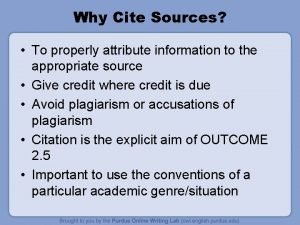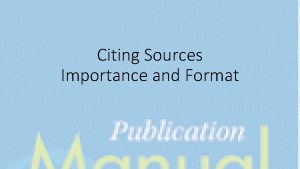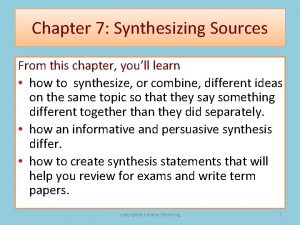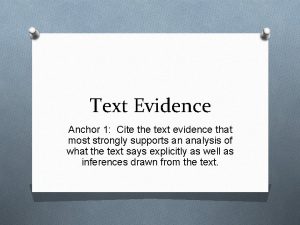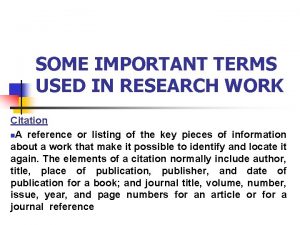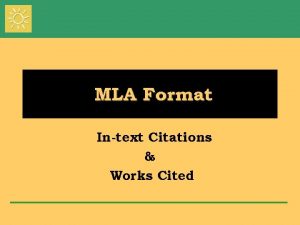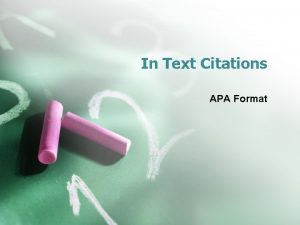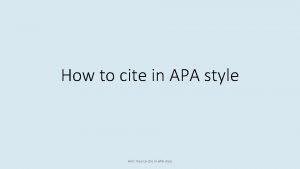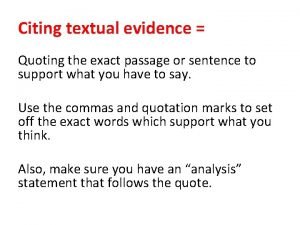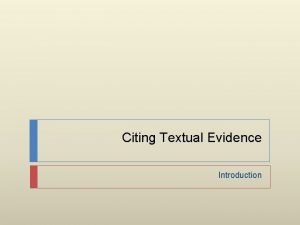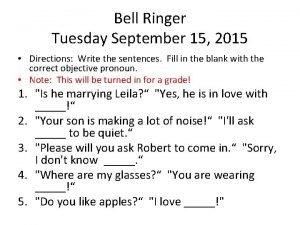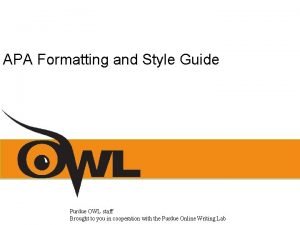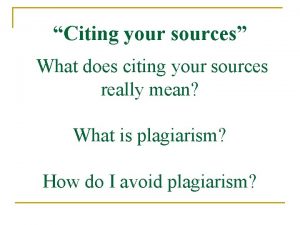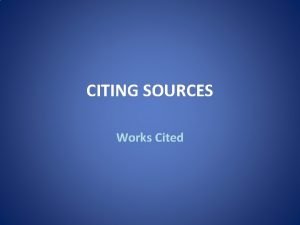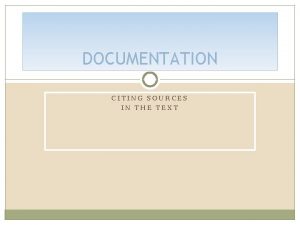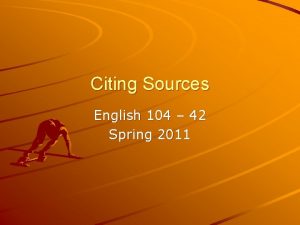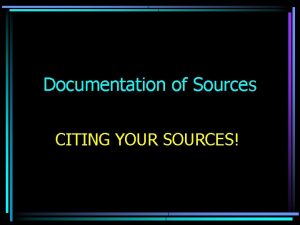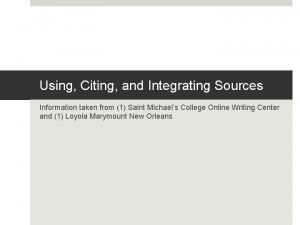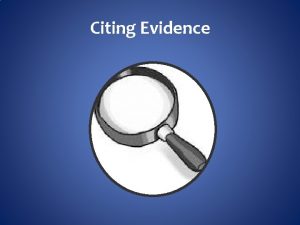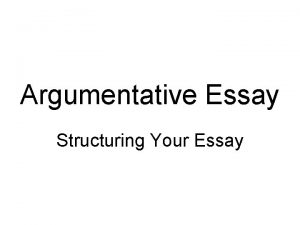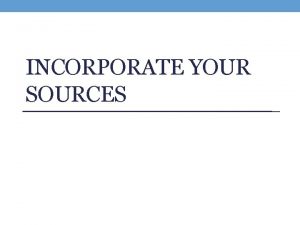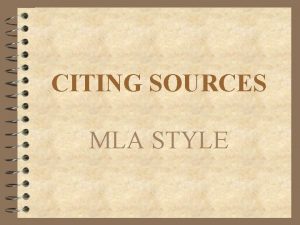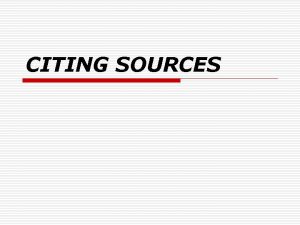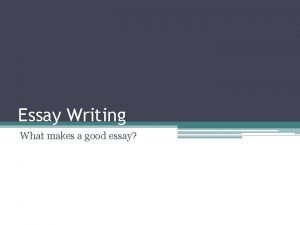INTEGRATING SOURCES INTO YOUR ESSAY Citing Sources in








![“Use [brackets] to change a quote” • Insert your own words • “She does “Use [brackets] to change a quote” • Insert your own words • “She does](https://slidetodoc.com/presentation_image/5d55a8e919ccacaeaa990f6749d46d6a/image-9.jpg)















- Slides: 24

INTEGRATING SOURCES INTO YOUR ESSAY

Citing Sources in MLA • In-text citations • Signal phrases • Parenthetical citations • Works Cited page with bibliography

In-text Citations According to A Pocket Style Manual, “When you cite sources, you give credit to writers from whom you’ve borrowed words and ideas” (Hacker and Sommers 108). Dianna Hacker and Nancy Sommers suggest that you don’t need to cite everything you look up during your research, but you should at least cite information that is “highly specific (as with statistics), or when it is controversial” (108).

Enclose borrowed language (word-forword) in quotation marks p. 109

Summaries and paraphrases • Summary • In your own words, using your own sentence structure • Keeps intent of original • Shorter than original • Paraphrase • In your own words, using your own sentence structure • Keeps intent of original • About the same length as original

When to use quotations 1. When language is especially vivid 2. When exact wording is needed for technical accuracy 3. When it is important to let the debaters of an issue explain their position in their own words 4. When the words of an authority lend weight to an argument 5. When the language of a source is the topic of your discussion

Ellipsis (Three periods with spaces between. . . ) Use to show omissions when you condense a quoted passage Lane acknowledges the legitimate reasons that many companies have for monitoring their employees’ online activities, particularly management’s concern about preventing “the theft of information that can be downloaded to a. . . disk, e-mailed to oneself. . . , or even posted to a Web page for the entire world to see” (12).

Ellipsis (Three periods with spaces between. . . ) Don’t use to begin or end a quote in your essay except when you have dropped words at the end of the final sentence. Charles Lewis, director of the Center for Public Integrity, points out that “by 1987, employers were administering nearly 2, 000 polygraph tests a year to job applicants and employees. . Millions of workers were required to produce urine samples under observation for drug testing. . . ” (22).
![Use brackets to change a quote Insert your own words She does “Use [brackets] to change a quote” • Insert your own words • “She does](https://slidetodoc.com/presentation_image/5d55a8e919ccacaeaa990f6749d46d6a/image-9.jpg)
“Use [brackets] to change a quote” • Insert your own words • “She does not understand [no, really? ] the context” • Clarify a confusing reference • “He [Jim] wanted it done right. ” • Insert a euphemism • “Frankly, my dear, I don’t give a [darn]. ” • To match the grammar or style of your own writing • “Brackets allow [writers] to insert [their] own words into quoted material. ” • “She leap[ed] across the pond. ” • “[T]he turbo encapulator may cost $750 billion, but think of how much it will save taxpayers in the long run. ”

Block quotes • Four typed lines • Introduce with informative sentence and signal phrase • Signal phrase is followed by a colon: • No quotation marks (only for indirect quotes and titles) • Must be word-for-word (or use ellipses and brackets) • End with parenthetical citation • Ending punctuation before parenthetical citation See example on p. 112

Signal Phrase A phrase, clause, or sentence that introduces a quotation, paraphrase or summary.

Signal Phrase "A signal phrase indicates the boundary between your words and the source's words” (Hacker and Sommers 113).

Signal Phrase According to A Pocket Style Manual, “When you cite sources, you give credit to writers from whom you’ve borrowed words and ideas” (Hacker and Sommers 108). Dianna Hacker and Nancy Sommers suggest that you don’t need to cite everything you look up during your research, but you should at least cite information that is “highly specific (as with statistics), or when it is controversial” (108).

Signal phrases establish authority • Source with no credentials • Jim Anderson points out that the law. . . • Source with credentials • Legal scholar Jay Kesan points out that the law. . . • Jay Kesan, professor of intellectual law at University of Illinois, points out that the law. . . • Kesan*, long-time resident of Chicago**, wants to change the city’s leash laws. *Note that you should use full name on first reference, but last name only thereafter. **Introduce each credential only once

What is the relationship between each intext citation and the Works Cited page? http: //iconbug. com/data/45/256/b 8 ad 52498 ca 47805 ec 9 a 1 b 96 af 2 fe 801. png

Must directly link to first word in Works Cited entry According to A Pocket Style Manual, “When you cite sources, you give credit to writers from whom you’ve borrowed words and ideas” (Hacker and Sommers 108). Diana Hacker and Nancy Sommers state. . . Hacker, Diana, and Nancy Sommers. A Pocket Style Manual. 6 th ed. Boston: Bedford/St. Martin, 2012.

Use Pocket Manual as a tool for learning • Verbs in a signal phrase (115) • Putting material in context (116) • Synthesizing sources(116 -18) notice omission of repeated hundreds column • Integrating literary sources (118 -21)

Should I ever repeat the author’s last name in a signal phrase and in a parenthetical citation for a single quote? Like this: Kesan wrote, “Lorem ipsum dolor sit amet, consectetuer adipiscing elit, sed diam nonummy nibh euismod tincidunt ut laoreet dolore magna aliquam erat volutpat. Ut wisi enim ad minim veniam, quis nostrud exerci tation ullamcorper suscipit lobortis nisl ut aliquip” (Kesan 1).

Should I ever repeat the author’s last name in a signal phrase and an in-text citation for a single quote? No, do not have redundant in-text citation when it is clear where a source begins and ends.

What about if I have a summary or paraphrase that is longer than one sentence? Smith et al. contend that lorem ipsum dolor sit amet, consectetuer adipiscing elit, sed diam nonummy nibh euismod tincidunt ut laoreet dolore magna aliquam erat volutpat. The authors added that ut wisi enim ad minim veniam, quis nostrud exerci tation ullamcorper suscipit lobortis nisl ut aliquip ex ea commodo consequat. OR Smith et al. contend that lorem. . Blah, blah. And then some more (Smith et al. ).

What if I am quoting an indirect quote (from a secondary source)? Let’s say I read an article in the Dixie Sun written by the reporter Keshara Bjorkman. I want to borrow a quote said by President Williams. It would look like this: Williams said, “I think my highest priority right now is to get a strategic plan in place … for us to move forward [and] really have a direction” (qtd. in Bjorkman).

MLA in-text citation models (122 -130) • Basic rules for print sources • Author in signal phrase • Author in parentheses • Author unknown (“Automatically”) • Page number unknown (either nothing or n. p. , depends) • Variations on the basic rules • Multiple authors (Kizza and Ssanyu; 4+ et al. ) • Organization as author (American Management Association) • Same last name (A. Jones 15) • Two or more by same author (“ 2003 E-mail” 2) • Two sources in same citation (Botan 29; Kizza and Ssanyu 3 -7) • Encyclopedia or dictionary (“Crocodile”)

MLA in-text citation models (122 -130) • Variations on basic rules cont’d • Multivolume work (2: 279) • Entire work (signal phrase only; no parenthetical) • Selection from anthology (cite author, not editor) • Government document (United States Department of the Interior) • Historical document (art. 4, sec. 3) • Indirect source (qtd. in Frauenheim) • Literary works and sacred texts • Verse from a play or poem • Novel with numbered divisions • Sacred text

You’ve got this! Remember that citing sources is not complicated, but it is complex. It isn’t difficult; it just requires attention to detail and lots of practice. Use your resources, and don’t make assumptions. If you can identify rules and model examples, you can cite anything in any style.
 Integrating sources into your writing
Integrating sources into your writing Signal phrases
Signal phrases How to write citation with 3 authors
How to write citation with 3 authors How to cite sources mla?
How to cite sources mla? Importance of citing evidence
Importance of citing evidence Synthesizing sources examples
Synthesizing sources examples Citing sources sentence starters
Citing sources sentence starters Print sources of information
Print sources of information Explain important of watershed management
Explain important of watershed management Difference between citation and reference
Difference between citation and reference To kill a mockingbird literary analysis
To kill a mockingbird literary analysis In text citation 3 authors example
In text citation 3 authors example Apa citation website no author
Apa citation website no author How to mla cite shakespeare
How to mla cite shakespeare Whats works cited
Whats works cited How to cite apa website with no author
How to cite apa website with no author Citing website with no author apa
Citing website with no author apa Harvard referencing citing
Harvard referencing citing Citing publications in resume
Citing publications in resume Citing evidence examples
Citing evidence examples What is textual evidence? *
What is textual evidence? * Citing text evidence sentence starters
Citing text evidence sentence starters Referencing multiple authors apa
Referencing multiple authors apa Apa citation for website with no author
Apa citation for website with no author Purdue owl headings
Purdue owl headings


